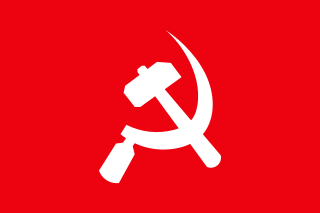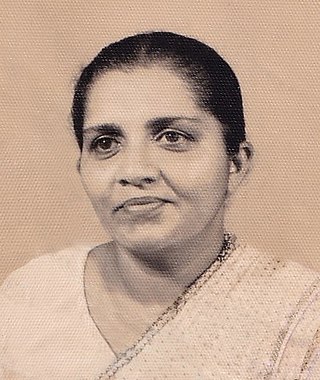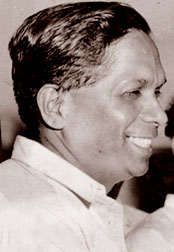
Nanayakkarapathirage Martin Perera, commonly known as Dr. N. M. Perera, was one of the leaders of the Sri Lankan Trotskyist Lanka Sama Samaja Party (LSSP). He was the first Trotskyist to become a cabinet minister. He served two terms as Minister of Finance and Leader of the Opposition, as well as one term as the Mayor of Colombo.

Bolshevik–Leninist Party of India, Ceylon and Burma (BLPI) was a revolutionary Trotskyist party which campaigned for independence and socialism in South Asia. The party was formed in 1942 as a unification of two Indian groups, with the Lanka Sama Samaja Party of Ceylon. It was recognised as the Indian section of the Fourth International.

The Lanka Sama Samaja Party, often abbreviated as LSSP, is a major Trotskyist political party in Sri Lanka. It was the first political party in Sri Lanka, having been founded in 1935 by Leslie Goonewardene, N.M. Perera, Colvin R. de Silva, Philip Gunawardena and Robert Gunawardena. It currently is a member of the main ruling coalition in the government of Sri Lanka and is headed by Tissa Vitharana. The party was founded with Leninist ideals, and is classified as a party with socialist aims.

Peduru Hewage William de Silva was a 20th-century Marxist/Trotskyist Sri Lankan politician.
Mark Anthony Lyster Bracegirdle was a British-born Australian Marxist revolutionary who played a key role in the Sri Lankan independence movement. He was one of the handful of European Radicals in Sri Lanka. He is most known for initiating the Bracegirdle Incident.

Colvin Reginald de Silva was a Sri Lankan Cabinet Minister of Plantation Industries and Constitutional Affairs, prominent member of parliament, Trotskyist leader and lawyer in Sri Lanka. He was one of the founders of the Lanka Sama Samaja Party, the first Marxist party in Sri Lanka.

Violet Vivienne Goonewardene, commonly known as "Vivi", was a Sri Lankan anti-colonial activist and prominent politician, serving as one of the world's first female ministers. A key figure in both the Indian independence movement and the Sri Lankan independence movement, Goonewardene was a prominent member on the non-aligned stage, where she fought against perceived injustices and was critical of the Middle East diplomacy sponsored by the United States. Goonewardene was the first and, to date, only female National Hero of Sri Lanka. By her death, she was one of the Left's most vibrant personalities, and the foremost female figure in the Sri Lankan leftist movement.
During the Donoughmore period of political experimentation (1931–48), several Sri Lanka leftist parties were formed in British colonial Ceylon. Unlike most other Sri Lankan parties, these leftist parties were noncommunal in membership.

The Sri Lankan independence movement was a peaceful political movement which was aimed at achieving independence and self-rule for the country of Sri Lanka, then British Ceylon, from the British Empire. The switch of powers was generally known as peaceful transfer of power from the British administration to Ceylon representatives, a phrase that implies considerable continuity with a colonial era that lasted 400 years. It was initiated around the turn of the 20th century and led mostly by the educated middle class. It succeeded when, on 4 February 1948, Ceylon was granted independence as the Dominion of Ceylon. Dominion status within the British Commonwealth was retained for the next 24 years until 22 May 1972 when it became a republic and was renamed the Republic of Sri Lanka.
After the outbreak of the Second World War, in the British Crown Colony of Ceylon, the government of Sir Don Baron Jayatilaka assured the British King and his government of its continued support.

Edmund Peter Samarakkody was a Ceylonese lawyer, trade unionist, politician and Member of Parliament.

Hector Abhayavardhana was a Sri Lankan Trotskyist theoretician, a long-standing member of the Lanka Sama Samaja Party (LSSP) and a founder-member of the Bolshevik-Leninist Party of India, Ceylon and Burma.

Don Philip Rupasinghe Gunawardena was a Sri Lankan Marxist politician and leftist. A founder of the Lanka Sama Samaja Party, the first political party in Ceylon which was known for having introduced Trotskyism, he later formed the Mahajana Eksath Peramuna and was called 'the Father of Socialism' and as 'the Lion of Boralugoda'. A member of the State Council of Ceylon and the Parliament of Ceylon, he served as the Minister of Agriculture and food under S. W. R. D. Bandaranaike from 1956 to 1959 and as Minister of Industries and Fisheries in the national government under Dudley Senanayake from 1965 to 1970.

Sugiswara Abeywardena Wickramasinghe was the founder of the Communist Party of Sri Lanka. He was the first Leftist to be elected to Ceylon State Council in 1931. He is considered one of the leading political figures in the twentieth century of Sri Lanka.
Anthony Theodoric Armand "Doric" de Souza (1914–1987) was a Sri Lankan Trotskyist politician, Senator, Professor of English and a brilliant Marxist theoretician.

Leslie Simon Goonewardene was a prominent Sri Lankan statesman. He founded Sri Lanka's first political party, the Lanka Sama Samaja Party, in 1935, and served as its General-Secretary from 1935 to 1977. Goonewardene was a key figure in both the Indian independence movement and the Sri Lankan independence movement. He was designated as a National Hero of Sri Lanka for his leadership in the independence movement, and his efforts are celebrated each year on the Sri Lankan Independence Day.
Vaithianathan Karalasingham was a Ceylon Tamil lawyer, writer, politician and one of the leading members of the Lanka Sama Samaja Party.

Don Benjamin Rupasinghe Gunawardena, popularly as Robert Gunawardena, was a Sri Lankan Marxist politician and diplomat. He was one of the founders of the Lanka Sama Samaja Party, which was the first political party in Sri Lanka, and served as the long time MP for Kotte. He was the leader of the Suriya-Mal Movement and served as ambassador to China between 1965 and 1970.
Bernard Soysa was a Sri Lankan politician.












